Tunisia is one of the most diverse countries in North Africa when it comes to bird species. With its location at the crossroads of several key bird migration routes, Tunisia has become a popular destination for birdwatchers from around the world.
The country boasts a rich variety of habitats, including coastal wetlands, mountain ranges, and vast desert regions, each of which supports a unique and fascinating array of birdlife.
From iconic birds of prey like the Barbary falcon to the vibrant blue and green hoopoe, visitors to Tunisia are sure to be captivated by the country’s feathered residents.
In this article, we will explore some of the most interesting and beloved birds found in Tunisia.
1. Houbara Bustard
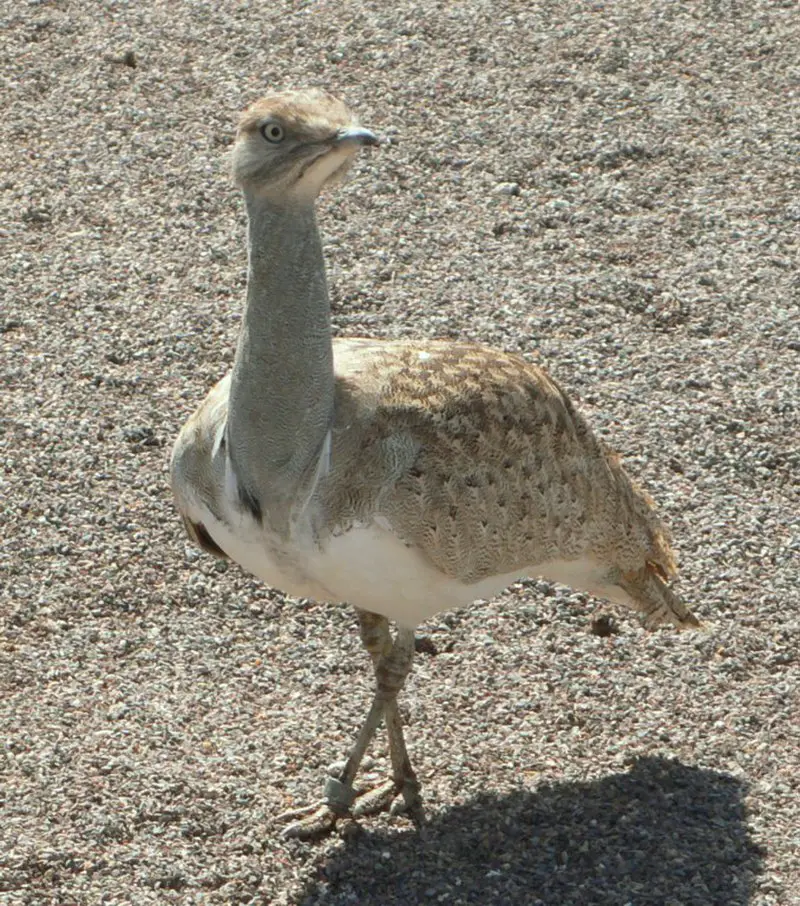
The Houbara Bustard is a small bird native to North Africa. It has dull brown feathers with black markings on the wings, and a grey crown of feathers atop its head.
This species inhabits arid habitats, making it particularly vulnerable in this environment due to lack of resources available.
The global population is listed as Vulnerable by IUCN Red List and there is also a population in the Canary Islands which has been assessed as Near Threatened.
Conservation efforts have been put into place but more needs to be done if we are going to protect these birds from endangerment or extinction.
We must ensure that their habitat remains protected so they can thrive in safety for generations to come.Scientific classification:
| Kingdom | Animalia |
| Phylum | Chordata |
| Class | Aves |
| Order | Otidiformes |
| Family | Otididae |
| Genus | Chlamydotis |
| Species | C. undulata |
Also Featured In: Native Pakistani Birds, Birds of Lanzarote
2. Collared Pratincole
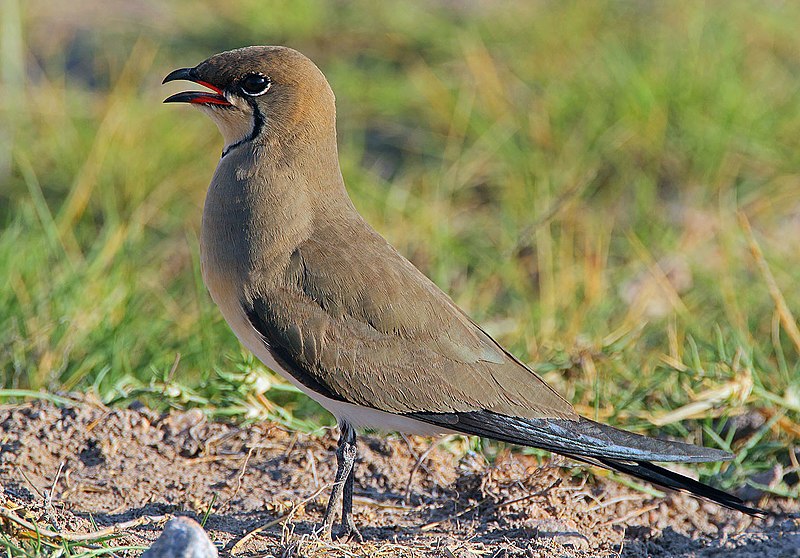
The Collared Pratincole is a small wader bird native to the Old World. It has distinctive long wings that are reddish-brown in color and have white tips, which give it its name.
Its body is mostly dark brown with some lighter spots along its back and sides. The bill of this species is short and pointed, making it a specialist for eating insects from mudflats or shallow waters.
During breeding season, they form loud flocks that can be heard from miles away when calling out their distinct song; during non-breeding time they disperse into smaller groups while searching for food sources in drier regions such as grasslands or fields.
This species relies heavily on open habitats where there are plenty of places to hunt for food throughout the year.Scientific classification:
| Kingdom | Animalia |
| Phylum | Chordata |
| Class | Aves |
| Order | Charadriiformes |
| Family | Glareolidae |
| Genus | Glareola |
| Species | G. pratincola |
Also Featured In: Beautiful Brazilian Birds, Birds That Live in Iraq
3. Cream-Colored Courser
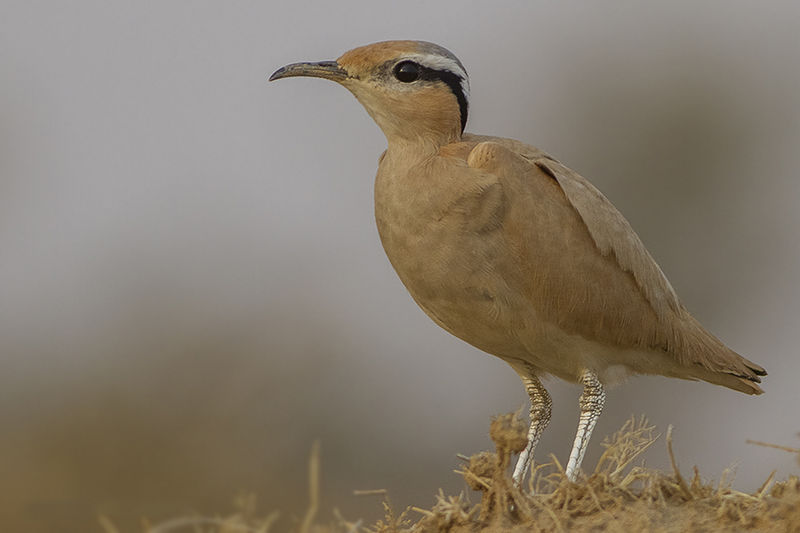
The Cream-colored Courser is a species of wader belonging to the Glareolidae family. It can be found across Western Asia and North Africa and inhabits dry, open semi-desert habitats.
These birds have adapted well to their environment; they are able to run quickly in search of insect prey on the ground which explains their scientific name Cursorius cursor – derived from Latin for ‘runner’.
The coursers also inhabit the Canary Islands as well as Cape Verde where breeding occurs during summer months before migration back south begins in autumn and winter months.
They are easily identified by their distinctive cream coloration with brown streaking along wings, neck and chest region making them an important part of these arid ecosystems.Scientific classification:
| Kingdom | Animalia |
| Phylum | Chordata |
| Class | Aves |
| Order | Charadriiformes |
| Family | Glareolidae |
| Genus | Cursorius |
| Species | C. cursor |
Also Featured In: Egyptian Birds, Turkey Birds You Should Know
4. Black-Necked Grebe

The Black-necked Grebe is a beautiful water bird belonging to the grebe family. It has an ochre coloured plumage with distinctive features which include extending behind its eyes and over its ear coverts.
The upper parts of this species are black, while their underparts and neck are white in colour.
During breeding season, males develop a dark grey crown on top of their head along with bright yellow facial stripes that run from the beak down to it’s chest area.
These birds feed mainly by diving underwater for insects, crustaceans, larvae, molluscs as well as small fish that they find in shallow waters or wetlands near freshwater lakes or streams.
They can often be spotted swimming alone but during winter months gather together creating large flocks due to mating activity taking place at these times.Scientific classification:
| Kingdom | Animalia |
| Phylum | Chordata |
| Class | Aves |
| Order | Podicipediformes |
| Family | Podicipedidae |
| Genus | Podiceps |
| Species | P. nigricollis |
Also Featured In: Most common Birds in France, Water Birds Live around Us
5. Red-Throated Loon
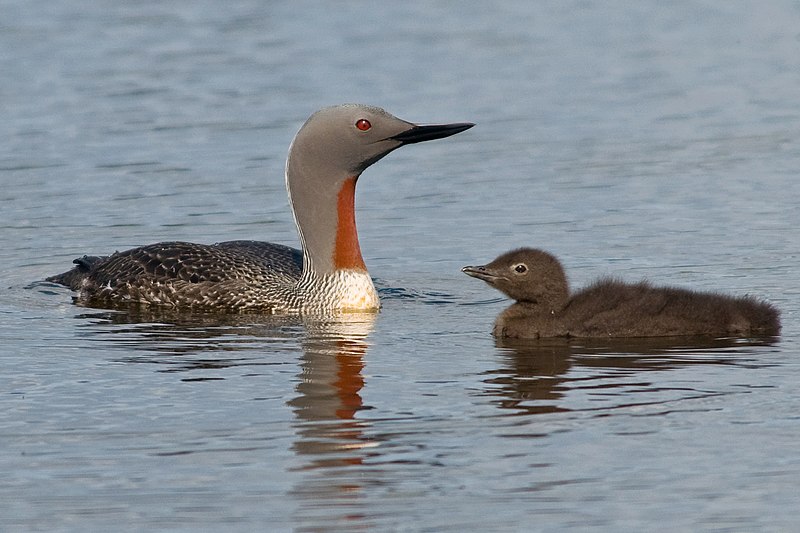
The Red-throated Loon is a migratory bird found in the northern hemisphere, with its breeding grounds primarily located in Arctic regions and wintering spots near coastal waters.
With an average length of 55 – 67 cm (22 – 26 inches), it’s the smallest member of the loon or diver family.
Its namesake comes from its bright red throat patch which contrasts against its white underside and grey back.
This species has adapted to life on icy seas; they are strong swimmers with powerful wings for long flights over open water when migrating seasonally.
Their diet consists mostly of fish but can also include crustaceans, molluscs, amphibians and insects depending on availability.Scientific classification:
| Kingdom | Animalia |
| Phylum | Chordata |
| Class | Aves |
| Order | Gaviiformes |
| Family | Gaviidae |
| Genus | Gavia |
| Species | G. stellata |
Also Featured In: Native South Korean Birds, Italian Birds You Should Know
6. Moussier’s Redstart
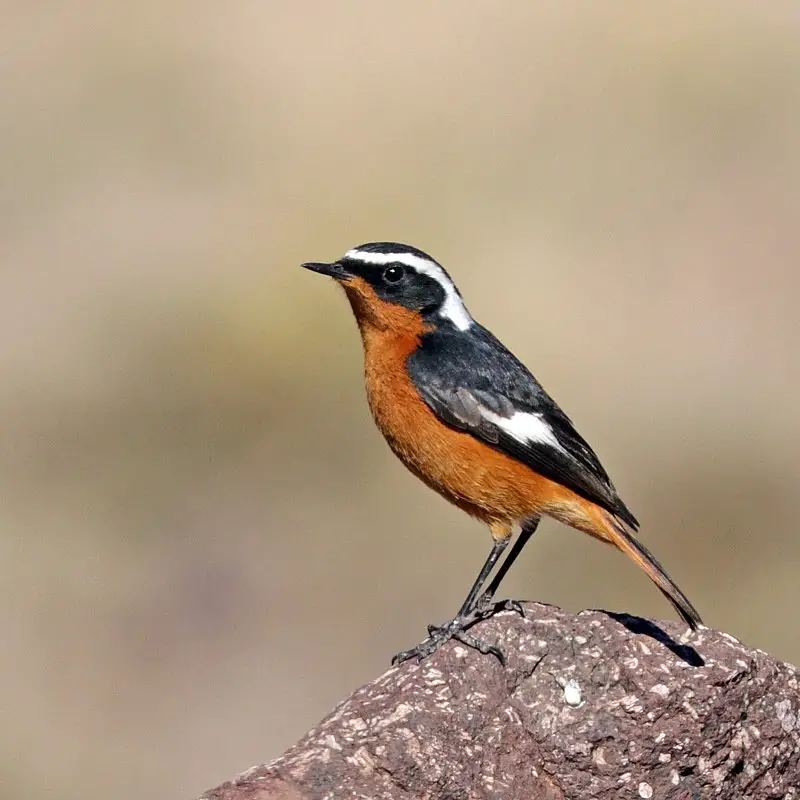
Moussier’s redstart is a small passerine bird found in the Atlas Mountains of northwest Africa. It has an endemic residence there, living and breeding in open woodland with rocky areas from sea level up to 3000m altitude.
This species was once classified as part of the thrush family but now belongs to Old World flycatchers (Muscicapidae).
They have a striking plumage – males are black on top with white bellies, while females are orange-brown above and paler below.
The head and tail both feature distinctive red patches for which it gets its name.
These birds feed mainly on insects but will also take berries when available. In winter they sometimes descend into lower altitudes or migrate further southwards if food supply is lowScientific classification:
| Kingdom | Animalia |
| Phylum | Chordata |
| Class | Aves |
| Order | Passeriformes |
| Family | Muscicapidae |
| Genus | Phoenicurus |
| Species | P. moussieri |
Also Featured In: Birds of Morocco, Common Algerian Birds
7. Barbary Partridge
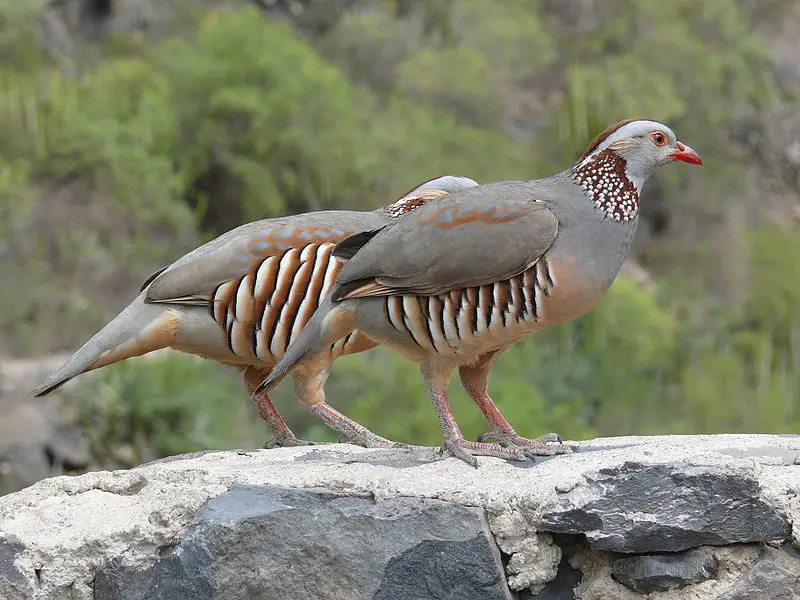
The Barbary partridge is a gamebird in the pheasant family, native to North Africa and surrounding regions such as Gibraltar and the Canary Islands.
It has been introduced to Portugal and Madeira with no recent reports of successful breeding populations outside its original range.
This species prefers open areas such as plains or scrubland, where it feeds on seeds, fruits, insects and small vertebrates like lizards. The males are larger than females with white spots on their chestnut-brown plumage.
Habitat loss due to overgrazing by livestock coupled with hunting pressure have caused declines in population numbers across much of their range making them vulnerable to local extinction if these threats continue unchecked.
Conservation measures are needed for this beautiful bird’s long-term survival.Scientific classification:
| Kingdom | Animalia |
| Phylum | Chordata |
| Class | Aves |
| Order | Galliformes |
| Family | Phasianidae |
| Genus | Alectoris |
| Species | A. barbara |
Also Featured In: Most Common Birds of Sardinia, Fuerteventura Island Birds You Need to See
8. Wilson’s Storm Petrel
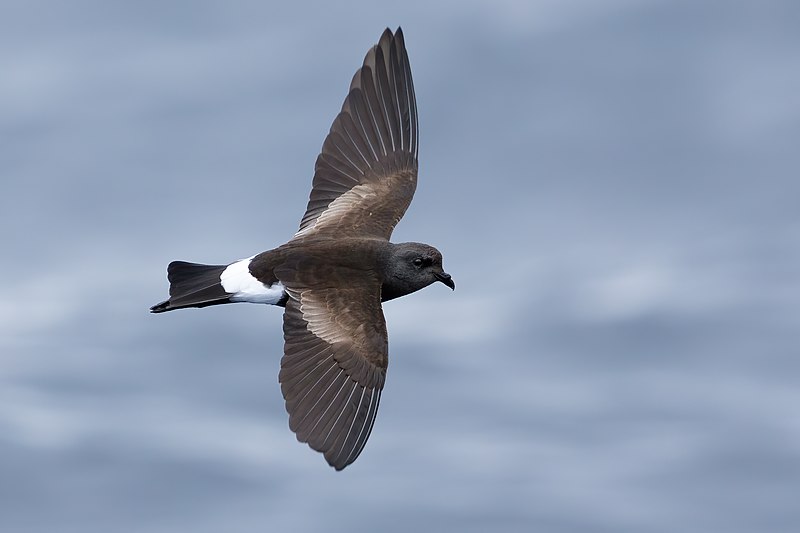
Wilson’s storm petrel is a small seabird of the Oceanitidae family. A circumpolar species, it can be found in both northern and southern hemispheres during summertime.
It has an abundance population estimated to be around 20 million birds as of 2022 making it one of the most populous bird species on Earth.
This nocturnal creature loves to feed on crustaceans, fish eggs and larval fishes that they catch while flying at night over open waters near coasts or islands.
During daylight hours Wilson’s Storm Petrel will rest in large groups and form colonies with fellow members for protection against predators like gulls and skuas which steal their food supplies if given opportunity.Scientific classification:
| Kingdom | Animalia |
| Phylum | Chordata |
| Class | Aves |
| Order | Procellariiformes |
| Family | Oceanitidae |
| Genus | Oceanites |
| Species | O. oceanicus |
Also Featured In: Dominican Republic birds, Birds You’ll Find in the Sea
9. Crested Lark
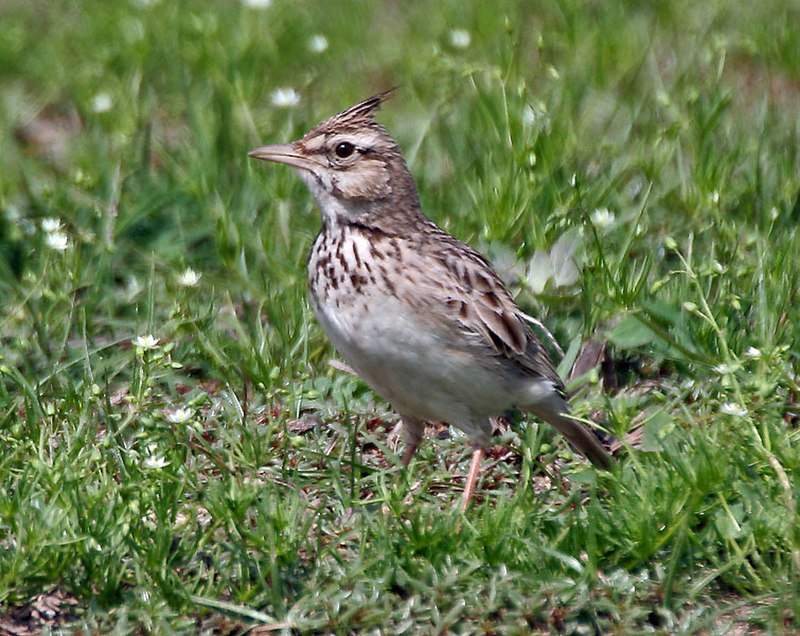
The Crested Lark is a species of lark that can be found across Eurasia and northern Africa. This non-migratory bird rarely appears as a vagrant in Great Britain.
It was originally described by Carl Linnaeus in 1758 for his 10th edition of Systema Naturae, under the genus Alauda until German naturalist Friedr Merrem moved it to its own genus Galerida in 1804.
The Crested Lark has an overall sandy color with darker brown wings and back, white underside, dark tail feathers and blackish bill.
Its most distinguishing feature are the two tufts on either side of its head which gives this species its name.Scientific classification:
| Kingdom | Animalia |
| Phylum | Chordata |
| Class | Aves |
| Order | Passeriformes |
| Family | Alaudidae |
| Genus | Galerida |
| Species | G. cristata |
Also Featured In: Common Birds of the Jordan, Belarus Birds You Should Know
10. Red-Rumped Wheatear
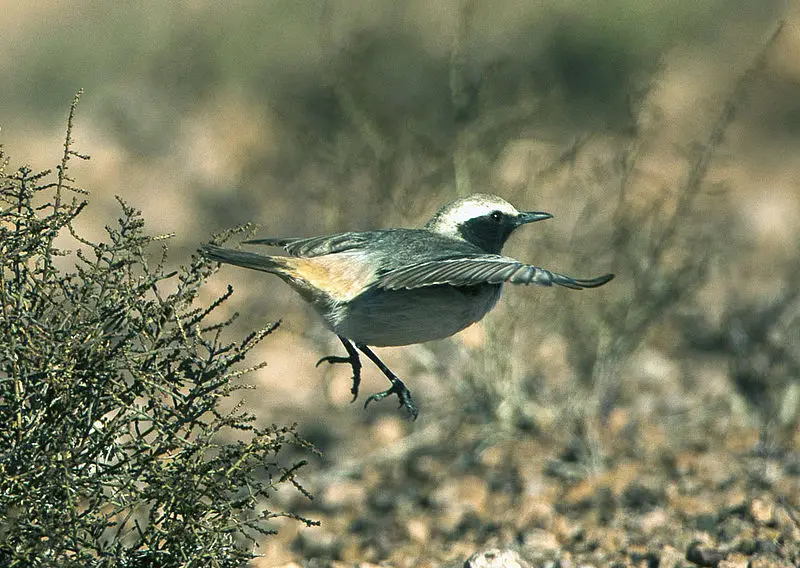
The Red-rumped Wheatear is a stunning bird species native to North Africa and the Middle East.
It has a distinct appearance, with an all black tail, rufous rump, grey crown and nape with a black throat and face as well as white supercilium on its shoulders and back.
Males have particularly striking features that make them stand out from females of the same species.
This small wheatear is one of many birds found in this region which makes it unique amongst other avian species in terms of size, shape and colouring.
Its diet consists mainly of insects but can also include some seeds depending on where they live geographically speaking.
They are mostly seen searching for food during daylight hours when temperatures are more moderate before returning to their roosts at nightfall or dusk time.
The Red-rumped Wheatear usually breeds between April until August making them active breeders throughout these months.Scientific classification:
| Kingdom | Animalia |
| Phylum | Chordata |
| Class | Aves |
| Order | Passeriformes |
| Family | Muscicapidae |
| Genus | Oenanthe |
| Species | O. moesta |
11. Northern Gannet
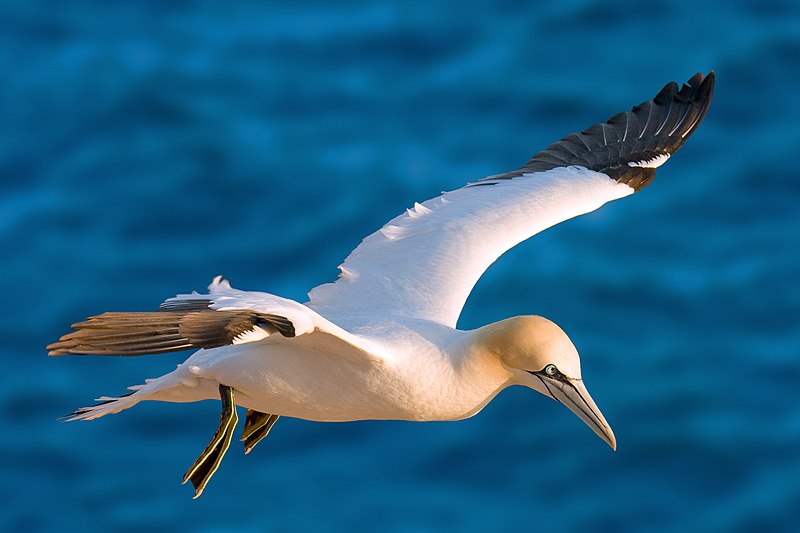
The Northern Gannet is the largest species of seabird in the northern Atlantic, with a white body and long neck.
It has yellowish head feathers and black tipped wings that can reach up to 6 feet across when fully extended.
The beak is large and orange-yellow in color. This bird breeds along western Europe’s coasts as well as northeastern North America.
They forage for fish by plunging into the sea from high above, making them an impressive sight to behold on any given day.
Their diet consists mainly of herring, mackerels or sand eels which they catch midair after diving at speeds reaching over 100 miles per hour.
With their striking features these birds are truly majestic creatures that have been around since prehistoric times – a testament to their hardiness and adaptability.Scientific classification:
| Kingdom | Animalia |
| Phylum | Chordata |
| Class | Aves |
| Order | Suliformes |
| Family | Sulidae |
| Genus | Morus |
| Species | M. bassanus |
Also Featured In: Birds found in portugal, Birds of Sweden
12. European Storm Petrel
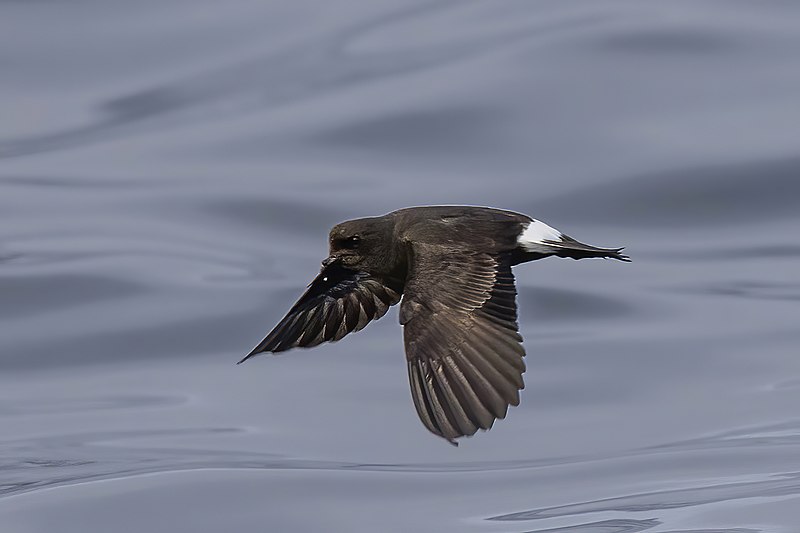
The European Storm Petrel is a small black seabird with a white rump and wings. It has an unusual, bat-like flight which flutters across the sky.
Its population mainly breeds on islands off the coasts of Europe, but can also be found in parts of North America as well as Japan and Korea.
They feed on planktonic crustaceans such as copepods by ‘pattering’ over water surface or dip-feeding where they plunge into the sea to catch their prey before flying away again.
These birds are elusive yet social when breeding; during this time they form colonies often near cliffs for protection from predators and harsh conditions at sea.Scientific classification:
| Kingdom | Animalia |
| Phylum | Chordata |
| Class | Aves |
| Order | Procellariiformes |
| Family | Hydrobatidae |
| Genus | Hydrobates |
| Species | H. pelagicus |
Also Featured In: Ireland Birds, Most Common Scotland Birds
13. Black-Crowned Tchagra
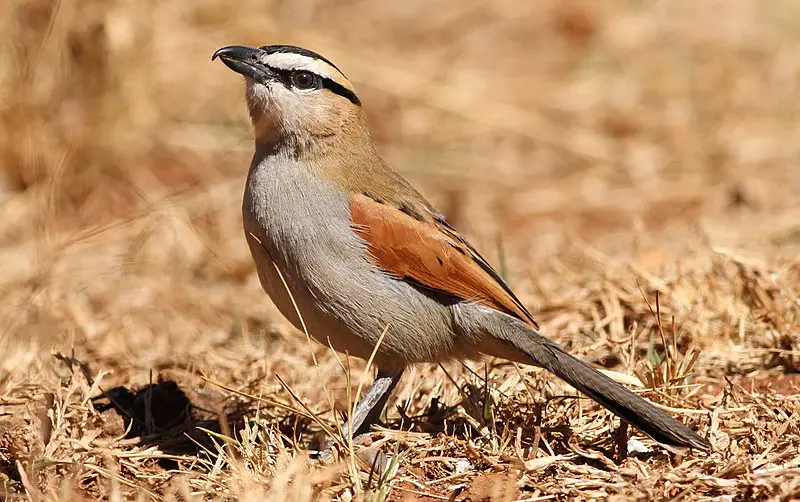
The Black-crowned Tchagra is a bushshrike found in the Arabian peninsula and most of Africa. It inhabits scrub, open woodland, semi-desert and cultivation areas.
This species has distinctive black crown feathers on its head with brown wings and tail that have white stripes running through them.
Its breast is mottled greyish-brown while its throat and belly are off white or pale yellow in colouring making for an attractive bird to behold.
The French zoologist Mathurin Jacques Brisson first described this bird back in 1760 as part of his encyclopedic ornithological work ‘Oiseaux’ (Birds).
Whether you live near the Sahara Desert or not, it can be fun to observe these birds during their active times so keep your eyes peeled.Scientific classification:
| Kingdom | Animalia |
| Phylum | Chordata |
| Class | Aves |
| Order | Passeriformes |
| Family | Malaconotidae |
| Genus | Tchagra |
| Species | T. senegalus |
Also Featured In: Gambia birds, Birds that Live in Benin
14. Terek Sandpiper
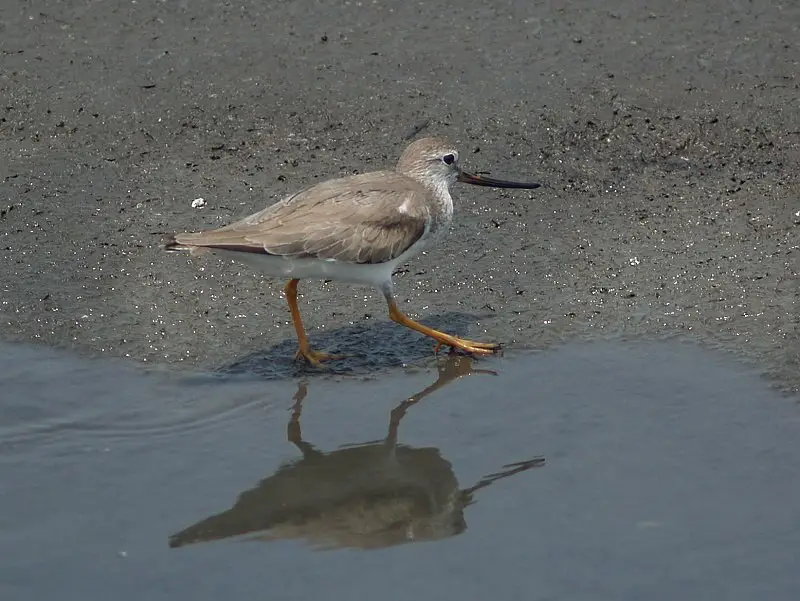
The Terek sandpiper is a small, migratory wader species belonging to the Palearctic region. It is named after the Terek River which flows into the west of Caspian Sea, where it was first spotted in 1775 by German naturalist Johann Anton Güldenstädt.
This bird has a mottled brown back and wings with white underparts and yellow legs.
Its diet consists mainly of insects but also includes crustaceans, molluscs and plant material found on mudflats during its breeding season in temperate regions like Siberia or northern China.
During winter migration they can be seen as far south as India or Australia making them one of few truly cosmopolitan shorebirds.
The species faces threats from habitat destruction due to human activities such as development for agriculture or industry leading to decrease in population size over timeScientific classification:
| Kingdom | Animalia |
| Phylum | Chordata |
| Class | Aves |
| Order | Charadriiformes |
| Family | Scolopacidae |
| Genus | Xenus Kaup, 1829 |
| Species | X. cinereus |
Also Featured In: Bahrain birds,
15. Red-Rumped Swallow
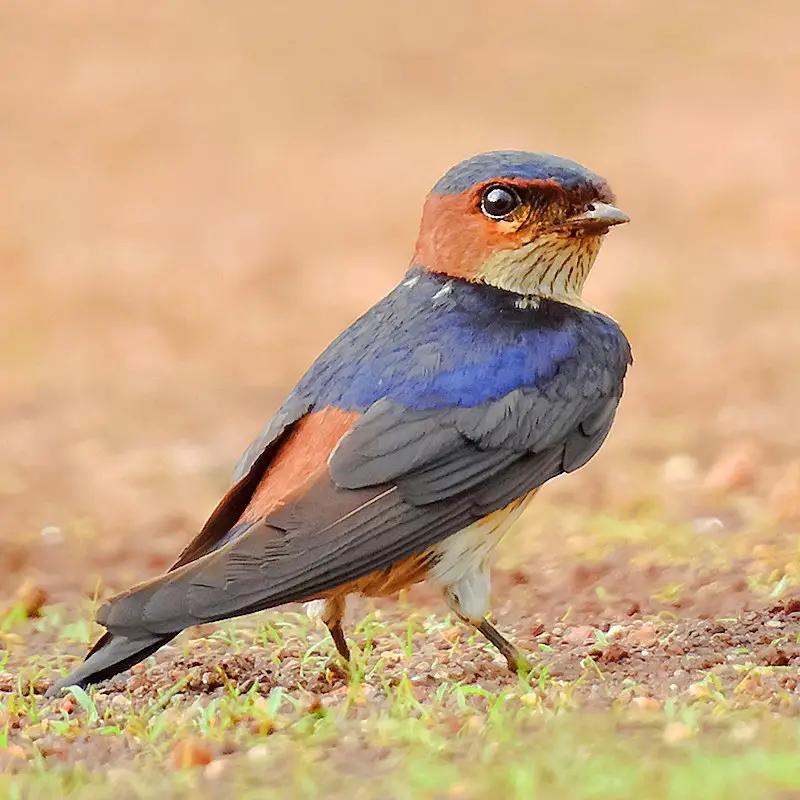
The Red-rumped Swallow is a beautiful bird of the swallow family that can be found in temperate southern Europe and Asia all the way from Portugal to Japan.
It breeds in open hilly country, while Indian and African birds are resident year round; however, European and other Asian swallows migrate south for winter to Africa or India.
These graceful creatures have even been observed as vagrants on Christmas Island. These small passerine birds are known for their striking red rumps which contrast against their otherwise dark blue plumage.
The diet of these swallows consist primarily of insects such as flies, bees, wasps etc., which they catch during short flights close to ground level.
So if you ever find yourself out in an open field near some hills this summer keep your eyes peeled for one of nature’s most stunning avian beauties -the Red-rumped Swallow.Scientific classification:
| Kingdom | Animalia |
| Phylum | Chordata |
| Class | Aves |
| Order | Passeriformes |
| Family | Hirundinidae |
| Genus | Cecropis |
| Species | C. daurica |
Also Featured In: Swallows Species, Birds You’ll Find in Albania
16. Melodious Warbler
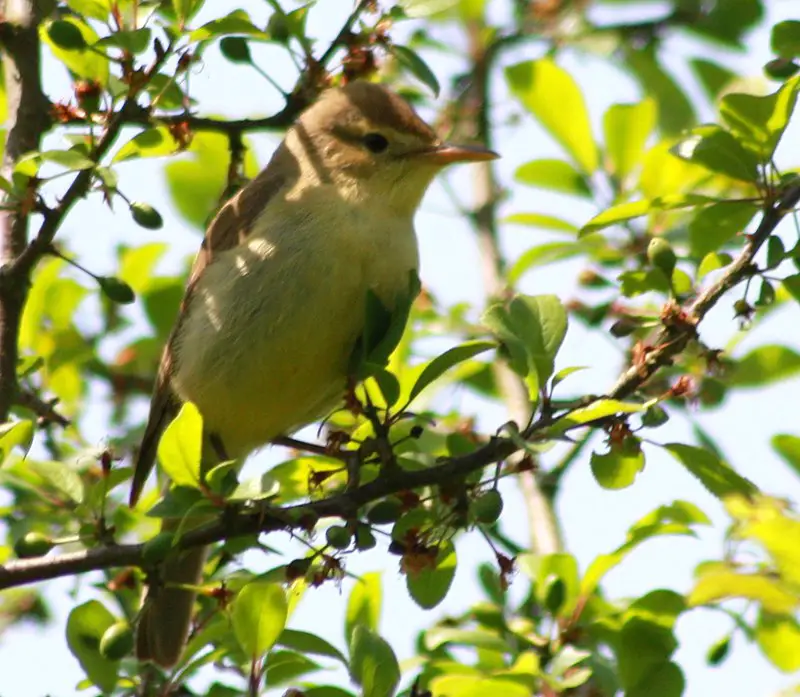
The Melodious Warbler is a small passerine bird found in open woodlands and bushes, typically throughout southwest Europe and northwest Africa.
During the summer months, it breeds in these locations laying three to five eggs in tree or bush-based nests.
In winter, however, they migrate southwards towards sub-Saharan Africa where they remain until spring comes round again.
This species has an incredibly wide range meaning that it is considered quite common across much of its habitat; making them one of the most frequently encountered warblers around.
Their song too makes them easily recognisable with many people noting their sweet melodies as being particularly beautiful.Scientific classification:
| Kingdom | Animalia |
| Phylum | Chordata |
| Class | Aves |
| Order | Passeriformes |
| Family | Acrocephalidae |
| Genus | Hippolais |
| Species | H. polyglotta |
Also Featured In: birds of pink,
17. Fulvous Babbler
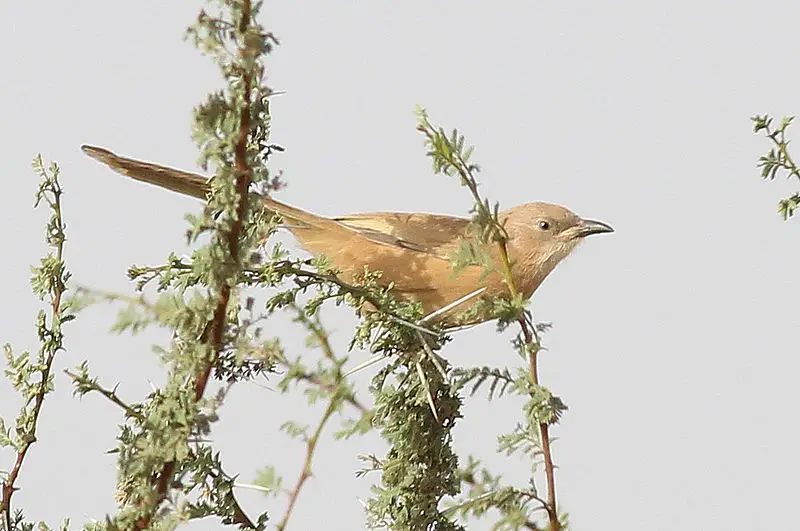
The Fulvous Babbler bird, also known as the Fulvous Chatterer, is a member of the Leiothrichidae family. This bird species measures around 25 cm in length, with a wingspan of 27-30.5 cm.
Its warm brown color dominates its upper body, with subtle streaking on the crown and back. The throat is white, while the underparts display a light brown hue.
The Fulvous Babbler bird is indigenous to northern Africa, and it’s seen as far south as the Sahel region.
Algeria, Chad, Egypt, Eritrea, and Ethiopia are its primary locations.
Despite being relatively small in size, the Fulvous Babbler bird is an essential member of its ecosystem, playing an essential role in its food chain.Scientific classification:
| Kingdom | Animalia |
| Phylum | Chordata |
| Class | Aves |
| Order | Passeriformes |
| Family | Leiothrichidae |
| Genus | Argya |
| Species | A. fulva |
18. Thekla’s Lark
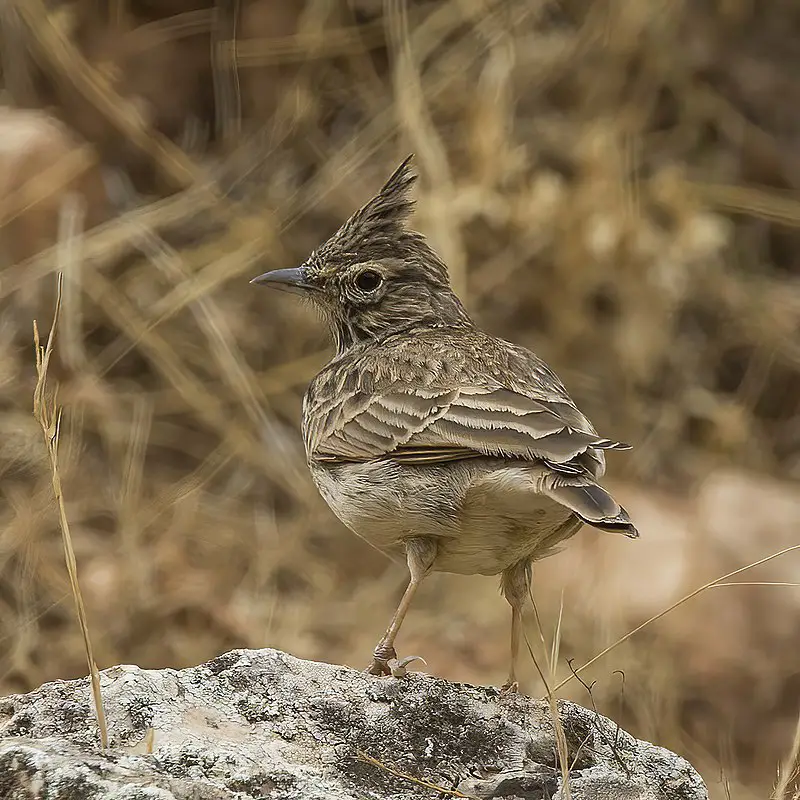
The Thekla’s lark, also known as the Thekla lark, is a non-migratory bird species found in various parts of Africa and the Iberian Peninsula. This bird is commonly found in dry open areas and at higher elevations.
It was named after Thekla Brehm by Alfred Edmund Brehm in 1857.Scientific classification:
| Kingdom | Animalia |
| Phylum | Chordata |
| Class | Aves |
| Order | Passeriformes |
| Family | Alaudidae |
| Genus | Galerida |
| Species | G. theklae |
Also Featured In: Most Common Spain Birds, Most Popular Birds in Mallorca